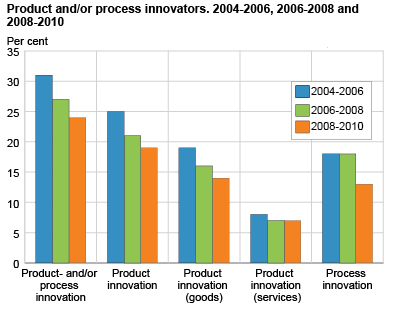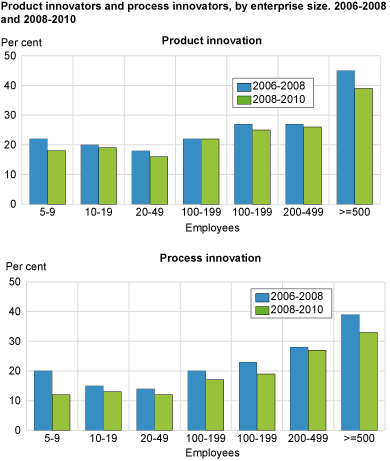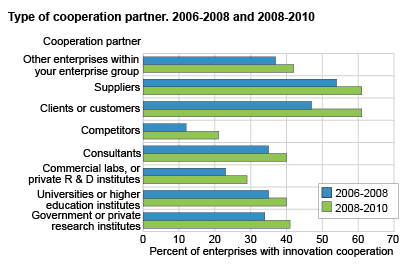Content
Published:
This is an archived release.
Fewer innovators among Norwegian enterprises
The share of Norwegian enterprises that introduced new products or new processes during the period from 2008 through 2010 fell three percentage points compared to the previous survey (2006-2008). These results show a continuing declining trend in the share of innovative enterprises observed from the previous two surveys.
Among the enterprises covered, a total of 24 per cent introduced new or significantly changed products and/or processes during the preceding three-year period. Nineteen per cent launched new products, while 13 per cent employed new processes. Nine per cent of the enterprises had both types of innovation. Furthermore, 5 per cent of the enterprises reported having ongoing innovation activity not yet having led to the introduction of an innovation or that they had abandoned such activities without it having led to an innovation being introduced by the enterprise.
In addition to product and process innovations, 20 per cent of the enterprises introduced organisational innovations, while 21 per cent introduced marketing innovations. This is roughly at the same level as reported in the previous innovation survey.
Broad decline in product and process innovators
Overall, the results show a reduction in the share of product or process innovators of 3 percentage points, from 27 to 24 per cent. This is a similar decline to the one observed in the previous survey. It is primarily being caused by a marked decrease in the likelihood that an enterprise will be a process innovator, but also by a fall in the share of enterprises introducing new or improved goods. The share of innovators introducing new services remained stable between the surveys. These reductions are seen almost consistently, regardless of enterprise size and main industry, but are most prominent for the smallest enterprises (5-9 employees) and in the services sector.
When considering only industries that are large enough to have an impact on the overall Norwegian enterprise sector, Telecommunications, Computer programming & consultancy, and Information service activities along with Other business support activities stand out as having the most prominent decline. Some industries also show an increase in the share of innovators. However, the statistical uncertainty for these estimates is not consistent and often relatively large. Thus, the results from this survey should not be used in isolation to draw too strong inferences about individual industries.
Increased importance of factors hampering innovation
Innovative and non-innovative enterprises alike had an increase in the share of enterprises reporting that one or more “hampering factors” had been of high or medium importance in preventing the enterprise from innovating or in hampering its innovation activities. The increase was strongest for the innovative enterprises, which saw the share of enterprises responding that all listed factors were “not relevant” cut almost in half; from 15 per cent during 2006-2008 to 8 per cent in the period 2008-2010.
As in previous surveys, hampering factors of a financial nature were the ones most frequently reported: Innovation costs too high , Lack of funds within your enterprise or group , and Lack of funds from sources outside your enterprise . The factor showing the biggest increase was Lack of qualified personnel .
The non-innovators also saw a decline in the share of enterprises reporting all hampering factors to be “not relevant”, from 62 to 58 per cent. Similarly, the non-innovators had an increase in the reporting for all the individual factors, although much smaller than for the innovative enterprises.
Fewer enterprises cooperate in innovation development
In addition to the decline in the share of product and process innovative enterprises, the survey also shows that fewer innovators cooperate with others when it comes to their innovation development. Overall, the number of enterprises that took part in an innovation cooperation was reduced by almost a third. Relative to the number of innovation active enterprises, this constitutes a decline of 8 percentage points in the share of enterprises involved in cooperation, from 36 to 28 per cent. As with product and process innovators, the decline in cooperation is also present across size groups and sectors.
At the same time, we see a marked increase in the number of different cooperation partners reported amongst the enterprises that do cooperate. This increase seems to be relatively evenly spread, and causes a noticeable increase in the share of enterprises that have had cooperation with any given type of partner. As in previous surveys, cooperation with Suppliers and cooperation with Clients or customers are most frequently reported. Cooperation with Competitors is still the least common form of cooperation, but this is also the partner that had the second largest increase since the last survey.
About the dataThe Norwegian survey on the innovation activity in the business enterprise sector, conducted by Statistics Norway, is part of the Eurostat Community Innovation Survey (CIS). The data discussed in this release belong to the seventh CIS survey (CIS 2010). The survey covers the entire manufacturing sector and large parts of the services sector along with selected other industries. The survey is in the form of a representative sample survey of enterprises with between 5 and 49 employees (20-49 in NACE groups G and H), with the addition of complete coverage of enterprises with more than 50 employees. Due to the CIS being in part a sample survey, there is an inherent statistical uncertainty to the results. This uncertainty is larger for the smaller size groups than for the larger ones. However, a calculation of the 95 per cent prediction intervals for the main variables in both CIS 2010 and CIS 2008 show that these do not overlap. Therefore there is a significant likelihood that the observed decline in innovation rates in our sample also represents a decline in the overall population of enterprises. This notion is further enhanced by the fact that a direct comparison between the results of enterprises that participated in both the past two surveys also shows a distinct and broad decline. |
Tables:
- Table 1 Enterprises with product- or process innovation by industry. Percent of population, 2010.
- Table 2 Enterprises with product- or process innovation by main industry and size group. Percent of population, 2010.
- Table 3 Who developed the enterprise's product innovations, by main industry and size group, 2008-2010
- Table 4 Product innovation new to the enterprise's market, by main industry and size group, 2008-2010
- Table 5 Objectives of the innovation activities. Share of enterprises reporting the objective in question to be of high importance, by main industry and size group. 2008-2010
- Table 6 Sources of information for innovation activities. Share of enterprises with innovation activity reporting the source in question to be of high importance, by main industry and size group, during the period 2008-2010
- Table 7 Factors hampering innovation activities for enterprises with innovation activity. Share of enterprises reporting the factor in question to be of high importance, by main industry and size group, during the period 2008-2010
- Table 8 Factors hampering innovation activities for enterprises with no innovation activity. Share of enterprises reporting the factor in question to be of high importance, by main industry and size group, during the period 2008-2010
- Table 9 Cooperation partners on innovation activities, by main industry and size group, during the period 2008-2010. Percent of enterprises cooperating on innovation
- Table 10 The use of patents and other methods of protection, by main industry and size group, during the period 2008-2010. Percent of enterprises with innovation activity
- Table 11 Organisational innovations, by main industry and size group carried through during the period 2008-2010
- Table 12 Marketing innovations, by main industry and size group carried through during the period 2008-2010
Contact
-
Lars Wilhelmsen
E-mail: lars.wilhelmsen@ssb.no
tel.: (+47) 40 90 24 35



